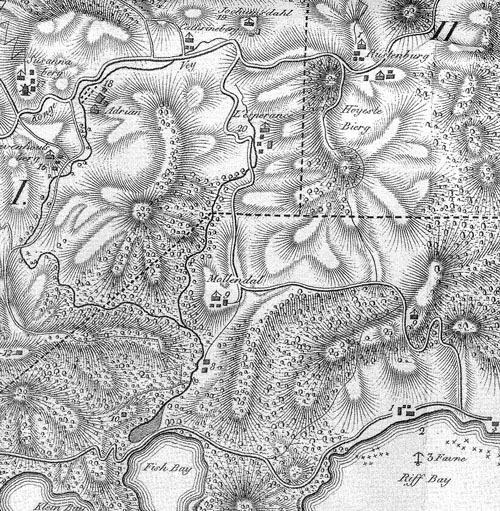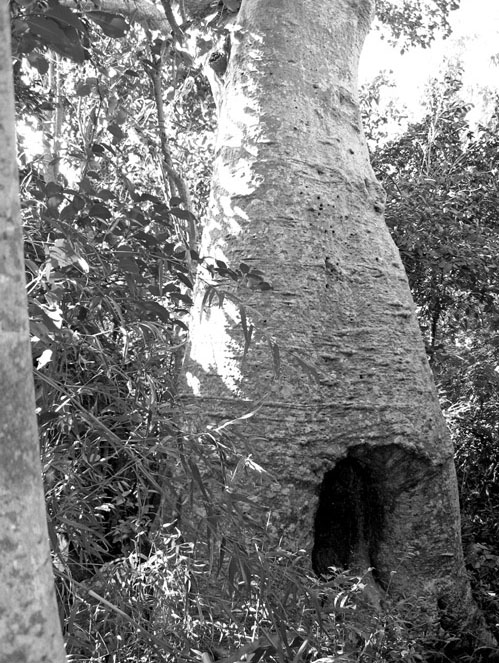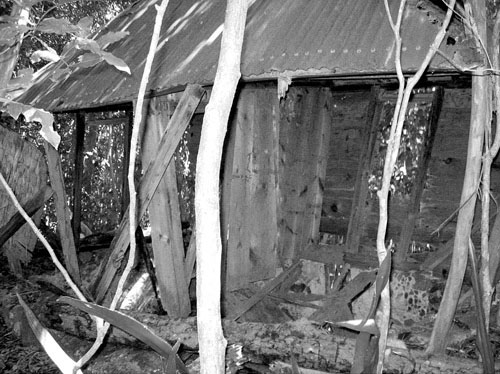Estate Sieben-Mollendal Hike
(Led by David Knight, summarized by Robin Swank)
Hardy SJHS members met for the last hike of the calendar year, to the south side estates of Sieben and Mollendahl. These estates are sheltered from the north wind by “Camel Mountain” (AKA: Camelberg), once thought to be the highest point on St John. David Knight led us down the Sieben Road, a major thoroughfare of the Colonial period, toward the L’Esperance cutoff; on December 15th it was cool and slippery, occasional raindrops keeping the guts flowing.
The hike was long and beautiful, the overgrown ruins proved to be rich time capsules, and the information overload daunting—here are just a few of the gems.

Oxholm’s updated 1800 map showing the combined
estates of Sieben and Mollendahl as “Mollendal”
The Estates
L’Esperance, David tells us, was formed in 1736 by the merger of two properties: one granted to Governor Erik Bredal and Amsterdam merchant Claus Tonis in 1721, and a 2/3 portion of another plantation granted to Capt. Christopher Krabbe in 1720. We stopped at the cutoff to L’Esperance where we could barely see the remains of an old bridge across the overgrown gut. David took this opportunity to point out that the Danes were adept road engineers. For example, until a land bridge was built that spanned the “Defile” — the “Rift” or fissure that splits the island in two at the head of the Reef Bay trail — east-west travelers would have to use trails down to the coastline to cross on horseback. When Oxholm did his survey of the island in 1780, he made note that the ‘bridge at the defile’ was nearly finished, overseen by Agent Wood of Estate. Once the bridge was completed, the roads down either side of the island diminished in importance. Sieben Road, however, remained a major thoroughfare as it connected the Cruz Bay Quarter with a number of active estates in the Reef Bay Quarter (Sieben, Mollendahl, Little Reef Bay, ParForce, and Reef Bay); it also continued on past Reef Bay to Lamesure, (the other) Mollendal, Salt Pond, Johns Folly, and on to Coral Bay. To this day, it remains a pretty substantial road.
Estate Mollendahl & Sieben was formed by a merger of the remaining 1/3 of the Krabbe property and four other estates owned respectively by: John Sieben (granted 1721), Elizabeth Friis (granted 1721), Adrian Charles (granted 1721), and Gerhard Moll (granted in 1720). The date of full consolidation was c1756.
Sieben, Mollendahl and L’Esperance are truly landlocked. Most estates had access to a Bay for transport, and if they didn’t they tried to purchase land to get access. Partly as a result of the added transport burden, these estates were never all that successful as sugar plantations. Quite early, as early as late 1820’s, they ceased to cultivate sugar. The remains of the sugar factories are, therefore, real relics of that early period. By 1793, the three estates (Mollendahl, Sieben, and L’Esperance) had come under the common ownership of Dr. D’Jurco Vriehuus, who controlled waterside estates at Reef Bay.
In 1805, all planters or estate managers were asked to write ‘elucidations’ concerning their properties on an agricultural census taken throughout the colony. The census was primarily taken in an effort to determine the labor situation on the estates after the cessation of the trans-Atlantic slave trade (the illicit slave trade did, in fact, continue in the West Indies into the 1880s.) As it turns out, these plantation censuses contain all manner of historical information not available to us in other official documents. For example, on the census for Annaberg the estate overseer noted that it was during James Murphy’s ownership that a modernized factory and windmill had been constructed on the property, a fact disclosed only in these elucidations.
David handed out transcribed excerpts from one of these handwritten plantation reports by Dr. D’Jurco Vriehuus, dated January 12, 1805. Setting aside descriptions of soil types, noxious insects (borer, blast, grub), and diseases (he was an MD as well as a planter), they read in part:
L’Esperance–
“The Estate is situated on the (Westend) of the island…. Two small rivulets run through the estate where one (is used to) water the works and has not been dry (for) 30 years that I have been here. It has agreeable to the opinion of those who understand it, water enough to supply a water mill which I have not been able to build on account of the heavy debt which rested on the estate when I bought it, the want of (laborers) on it, dry years and lastly hurricane.”

The Estate Sieben Baobab tree still stands,
now protected by a large nest of bees…
As Mr. Elroy told us, “the tree is easier
to find if you just look up.”
Mollendahl and Sieben–
“The land of these estates are situated on the South side of this Island…there are two sets of convenient works on them. That these Estates do not at present yield more sugar in a better proportion to their number of Negroes, is owing to some of the Negroes have worked a couple of years in the lands of my Estate L’Esperance, which lie contiguous to, and are better than these lands… To cultivate all the good land, 60 to 70 more would be required…”
“As men have wives, and women husbands upon this Estate, the husbands go generally to their wives where they live. Such as live in matrimony on the Estate occupy one house inhabited by a pair and their children…”
“The Buildings and Negro houses of Sieben are on the side of a hill open to the East and South winds. Those of Mollendahl on the side of a hill facing West. The Negro Houses are in general 20 to 24 feet long, and 10 to 12 wide. Those of the house negroes and Tradesmen are larger… (They) have in good weather not only provisions enough for their own subsistence, but also to dispose of for money; to that, a few negroes excepted, I need not buy for the others any other but salt provisions. That they may keep their grounds in order, I give them out of crops one day in the week to work for themselves, which they prefer to being fed.”
Dr Vriehuus goes on very directly addressing the amelioration question and identifying the inhibitors of a self-sustaining labor population–the spread of VD; sterility caused by polygamy, too–hard labor conditions and guilt–induced abortions; and the government mandated redirection of the labor force to the making and repairing of roads instead of sugar.
As David passed around a copy of the original text of Vriehuus’ elucidation, he passed on a primary research tip learned from his friend and associate Garry Horlacher. In undertaking translation of Danish archival materials it is not only helpful to be able to decipher Gothic script, but also to know some contemporary Norwegian, as in many cases today’s Norwegian is closer to old Danish than is modern Danish.
At the slippery turn-off to the Baobab Tree on estate Sieben, one of our members takes a tumble; with a painful dislocated shoulder and with the aid of several members and only 2 aspirins, Paula bravely travels all the way back up the Sieben Road to Centerline to await EMS and other myriad service vehicles. Paula, we are glad you are recovered; you are a trooper!
We do find the baobab tree.
We stop for several stories along the way, stories which bring the people of the period alive for us. (The story of Brother Tutweiler’s visit to Mollendahl will appear in the February newsletter due to space limitations… We also hear about Alexander Frazier, who was the owner of the Sieben Estate during emancipation. He was one of a small group of English planters on Tortola who relocated to the DWI to broaden ownership opportunities for his mixed-race children. Alexander Frazier was a friend and lawyer of AC Hill; he was also the Quarter Officer for the Reef Bay Quarter of St. John. Despite his lawyerly responsibilities for friends and crown, and the prodigious amount of documentation he collected on every facet of his official life (every bill, note, correspondence, troop drill, etc), he died without leaving testament regarding his own possessions. Therefore, all were invited to submit claims to his estate at his death. As a result, his Probate records are humongous! Interestingly, claimants were not interested in his plantation, which was valued at only $400, but in the compensation due from the Danish Crown for his emancipated slaves, which were valued at $50 each. Because of his dying intestate, Frazier’s intended St John heirs, all born out of wedlock, were left with no claim to his property.
The Sieben Estate buildings were destroyed in a major hurricane in the 1830’s the buildings we saw there were built since. As is common in multi-generational sites, the later-period house was rebuilt incorporating elements of what had previously been the sugar factory. (During that hurricane it was reported that fruit trees were uprooted, sheep killed and the coffee crop destroyed at L’Esperance.)

Wide boards on a foundation of field-stone and rubble,
set with quicklime mortar are remnants of a
comfortable 2 room house among the Bay Rum trees.
The detail of the house’s careful construction is worth
a picture-taking visit.
We then head farther down the Road to the Mollendahl Estate, where the humid air is scented by abundant bay rum trees (Pimenta racemosa). The estate was named by Gerhardt Moll for his son, who was sent to Holland for his education. Gerhardt was blind; we know this because his wife Maria, who inherited the estate as guardian in 1754, tells us so in an inscription she had engraved on his gravestone in the STT Danish cemetery. Maria led a troubled life–her son died before reaching his majority, so she remarried, passing title of the lands to her second husband, Commandant John van John, a duplicitous type who died in office. She tried again with Captain Wencel Kass, with whom she had two daughters before the plantation was sold.
While at Mollendahl we observed remnants of a community of in-holdings where tradesmen and bay-rum leaf harvesters once lived. These plots held by the free community were legitimized in the 1870s and 1880s. We see one of about 12 houses, some partially intact; the early craftsmanship is still evident.
David informed us that bay rum oil was originally used as lubricating oil. At full strength it will burn your skin; it is diluted at various strengths depending on its intended use. SJHS member Chuck Pishko noted that pure bay oil is diluted 1 in 500 parts, e.g., when used as a scented oil/toilet water. The St Johnian bay leaves were distilled into oil by families with names like Marsh, White, Bornn and Lindquist, and then shipped to St Thomas where they were manufactured into bay rum.
We reluctantly leave the cool canopy of trees for the trek back uphill, which was almost as much fun as the hike down. I’m certain many of us will be taking this hike again, to make sure that these time capsules are still intact. For those interested in more information on the chain of title of these Estates, David’s notes are available for review in our Archives.
